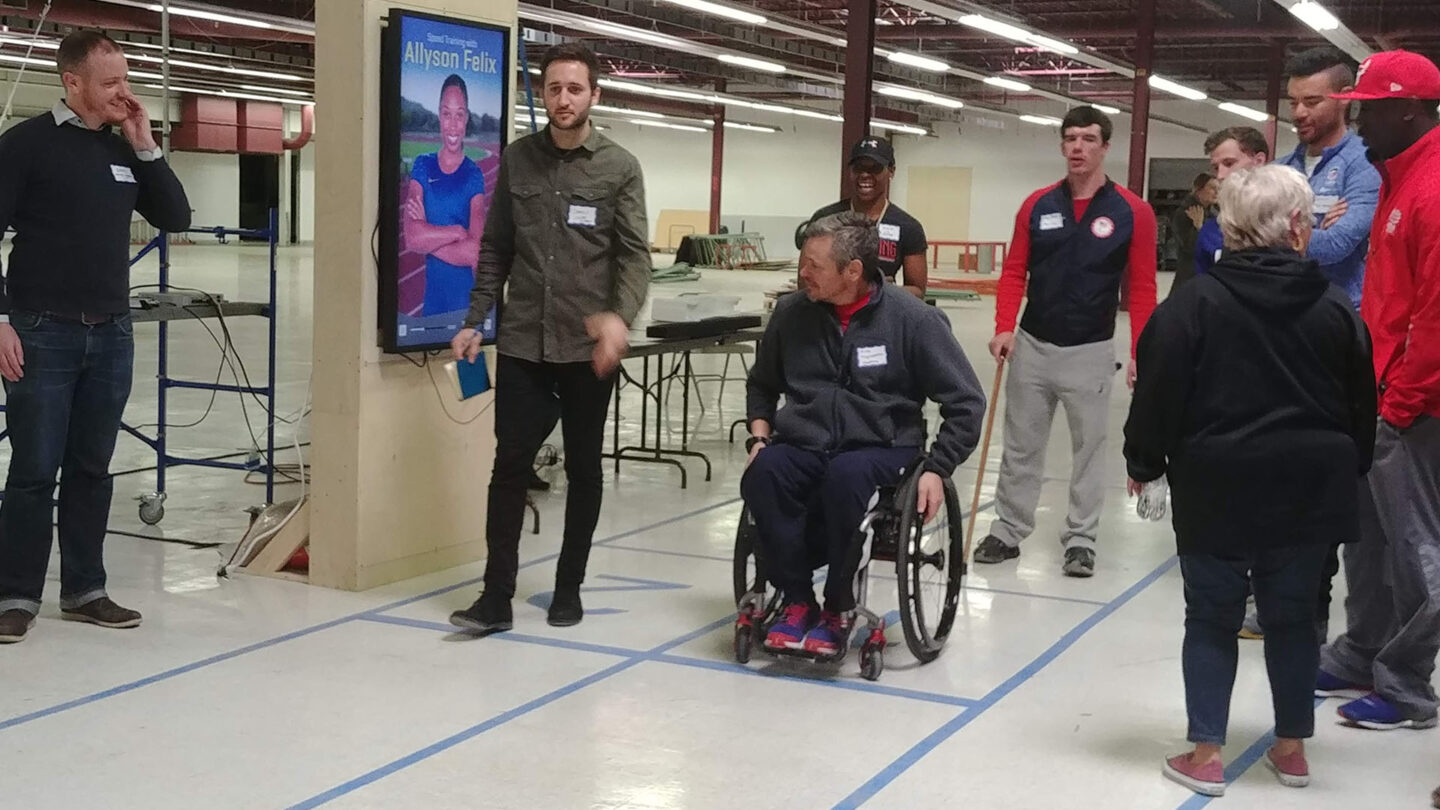United States Olympic and Paralympic Museum
With Paralympians and Olympians sharing equal billing, the Museum is an inclusive experience through its content and design, its heroes and visitors, its architecture and, of course, its interactives. The visitor learns about a particular skill important to a wide number of Olympic and Paralympic sports, and then puts that skill into practice via a short training exercise.
Agency
Gallagher & Associates
CREO Industrial Arts
Centre Screen
Practice Area
Client
United States Olympic & Paralympic Museum
Industry

The Challenge
How to create interactive challenges that blend the digital and the physical, challenge the elite as well as novices and ultimately allow all visitors to participate and learn through play in a safe and engaging museum environment?
Project Vision
The vision from the outset was to prioritize inclusivity while building experiences that engage, educate and entertain. With Paralympians and Olympians sharing equal billing, the Museum was an opportunity to create an inclusive experience through its content and design; its heroes and visitors; its architecture and, of course, its interactives.

User testing an early prototype of the Archery interactive game with Paralympian athletes, and the final Archery interactive experience on-gallery at USOPM.
Creo Industrial Arts & Nic Lehoux

User-testing an early prototype of the Track & Field interactive with U.S. Olympic and Paralympic athletes. The challenges here included interacting with the introduction screen as well as the track.
Creo Industrial Arts

Testing the Goalball interactive prototype. One of our users during testing was a blind/low vision swimmer who was able to work with us to co-design a solution for audio-led aim.
Creo Industrial Arts

User testing the Skeleton game. Working with various groups, we were able to gain a diversity of opinion on many factors of gameplay and create authentic experiences for all.
CREO Industrial Arts & Nic Lehoux
Design + Execution
Whatever the visitor’s method of interaction, how to create a consistent language, visually and semantically? For visitors who cannot control a touchscreen, how to offer intuitive ways to navigate content? How do visitors know where the keypad will be? When a visitor enters the Museum with a need for a lower-sensory experience, how to inclusively offer toned-down content? If a visitor can’t navigate an experience visually, how to offer an equivalent experience via sound and touch? For visitors who cannot hear content, how to design rich experiences? Where screens are a variety of formats and heights, how to ensure the user interface is always accessible, and content always visible to all?
The team facilitated seamless personalization using RFID and personalized registration. Up front, visitors determine the services that they will find most useful throughout their visit and those settings become their digital fingerprint throughout, carried on their RFID profile and recognized instantly, from a distance, on any media or interactive interface they encounter.
Co-design and user-testing was embedded throughout, ensuring the design met all needs and no decisions were made in isolation of other inputs.

The Skeleton interactive being tested at final installation on site, Gallery 4 at the United States Olympic & Paralympic Museum.
CREO Industrial Arts & Nic Lehoux

Gallery 4 at the United States Olympic & Paralympic Museum.
CREO Industrial Arts & Nic Lehoux

The Speed Training running track, Gallery 4 at the United States Olympic & Paralympic Museum.
CREO Industrial Arts & Nic Lehoux
Project Details
This museum takes inclusive design to the next level – actually to the level it belongs. It will hopefully be an example for future museums.
USOPM has set the new standard for inclusive design and experience. It's refreshing to see the mission of an institution mirrored in its commitment to accessible visitor experience.
In a world that still often views accessibility as extraneous to the design process, this museum showcases the power of designing to include and dignify each and every person.
To make truly inclusive experiences, your design process must also be inclusive and collaborative. These interactive experiences are clearly the product of not only a stated desire of accessibility, but also an iterative and collaborative design process with expert users. I appreciated the details of how each interactive experience was designed to deliver an authentic experience of sport, in a way clearly tailored to be accessible to all. Really loved this project, and I want to see more museums follow their example.
Design Team
Gallagher & Associates, Carl Rhodes (design director)
CREO Industrial Arts, Al Salm (project director), Mary Olson (project manager), Jon Garcia (fabrication design manager)
Centre Screen, Hayley Walsh, Lisa O’Neill (project director), Dan Cooper (head of interactive), Joel Hepworth (creative – graphics & motion designer)
Collaborators
CREO Industrial Arts, Al Salm (project director), Mary Olson (project manager), Jon Garcia (fabrication design manager), Warner Scheyer (software engineer / interactives specialist), Declan Fox (interactives engineer)
Gallagher & Associates, Carl Rhodes (design director)
Gallagher Museum Services, John Christie (owner’s representation, operations management)
CREO Industrial Arts (exhibit fabrication)
Barrie Projects, Kathy Barrie, (museum, feasibility study consultant, content & artifact acquisition)
Barrie Projects, Dennis Barrie (museum, feasibility study consultant, content & artifact acquisition)
Centre Screen (audio visual & interactive design and production)
Kiss the Frog, Remco Molenaar, (interactive development project manager), Ramon van Bezouw (interactive software developer), Barry van Dam (interactive software developer)
BBi Engineering, Jim Sallee, (hardware consultant & integrator)
Stark RFID, Charlie Little (RFID consultant & integrator)
Institute for Human Centered Design, Janice Majewski (inclusive design & accessibility consultant), Anoopa Sundararajan (inclusive design & accessibility consultant)
Diller Scofidio + Renfro (architect)
Anderson Mason Dale Architects (architect of record)
Available Light (lighting design)
RGLA (retail & cafe design)
Photo Credits
CREO Industrial Arts & Nic Lehoux (photography)
Gallagher & Associates (videography)
CREO Industrial Arts (videography)
Centre Screen (videography)
Open Date
July 2020




